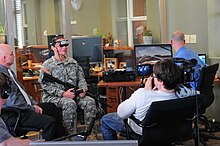User:Rfr5240/sandbox
Technology can range from a simple PC and keyboard setup to a modern virtual reality headset. It is widely used as an alternative form of exposure therapy, in which patients interact with harmless virtual representations of traumatic stimuli to reduce fear responses.
Unlike traditional cognitive behavioral therapy, VR-based treatment may involve adjusting the virtual environment, such as adding controlled intensity smells or adding and adjusting vibrations and allow the clinician to determine the triggers and triggering levels for each patient's reaction.
On the other hand, what is referred to as graded-exposure takes a more relaxed approach in which the least distressing stimuli are introduced first. VR-exposure, as compared to in-vivo exposure has the advantage of providing the patient with a vivid experience, without the associated risks or costs.
Augmented reality poses additional benefits and has proven itself to be a medium through which individuals suffering from a specific phobia can be exposed "safely" to the object(s) of their fear, without the costs associated with programming complete virtual environments.

The preference of virtual reality exposure therapy over in-vivo exposure therapy is often debated,......(added a link to exposure therapy since it might help enhance the understanding of the article)
Added the following thumbnail image on the right with the following caption in the section of exposure therapy in terms of psychological use of virtual reality therapy.
Gynecological surgery
VR based treatment has been useful in treating preoperative anxieties in women who potentially undergo minor gynecological surgeries. Women undergo higher levels of emotional stress and trauma than men before a minor surgical procedure.[1]The use of 10 min VR treatment offered significantly reduced levels self-reported stress and anxiety before gynecological procedures as well as increased levels of wound healing.[1] VR was also shown to decrease chronic pain intensity while increasing patient satisfaction with minimal side effects after a gynecological surgery.[1]
- ^ a b c Chan, Jason Ju In; Yeam, Cheng Teng; Kee, Hwei Min; Tan, Chin Wen; Sultana, Rehena; Sia, Alex Tiong Heng; Sng, Ban Leong (2020-12). "The use of pre-operative virtual reality to reduce anxiety in women undergoing gynecological surgeries: a prospective cohort study". BMC Anesthesiology. 20 (1): 261. doi:10.1186/s12871-020-01177-6. ISSN 1471-2253.
{{cite journal}}: Check date values in:|date=(help)CS1 maint: unflagged free DOI (link) - ^ North, M. M.; North, S. M.; Coble, J. R. (1997). "Virtual reality therapy: an effective treatment for psychological disorders". Studies in Health Technology and Informatics. 44: 59–70. ISSN 0926-9630. PMID 10175343.
- ^ Boeldt, Debra; McMahon, Elizabeth; McFaul, Mimi; Greenleaf, Walter (2019). "Using Virtual Reality Exposure Therapy to Enhance Treatment of Anxiety Disorders: Identifying Areas of Clinical Adoption and Potential Obstacles". Frontiers in Psychiatry. 10. doi:10.3389/fpsyt.2019.00773. ISSN 1664-0640.
{{cite journal}}: CS1 maint: unflagged free DOI (link) - ^ "Speaking of Psychology: Improving lives through virtual reality therapy". American Psychological Association. January 2015.
{{cite web}}: CS1 maint: url-status (link)
 | This is a user sandbox of Rfr5240. You can use it for testing or practicing edits. This is not the sandbox where you should draft your assigned article for a dashboard.wikiedu.org course. To find the right sandbox for your assignment, visit your Dashboard course page and follow the Sandbox Draft link for your assigned article in the My Articles section. |
